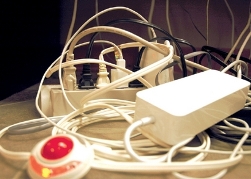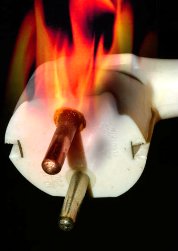Categories: Featured Articles » Electrician at home
Number of views: 54528
Comments on the article: 22
How to ensure fire safety of electrical wiring in an apartment and a house
 According to any, even the most superficial studies, faulty electrical wiring in the house or an apartment is dangerous, first of all, not because of the risk of electric shock, but because of the prospect of a fire.
According to any, even the most superficial studies, faulty electrical wiring in the house or an apartment is dangerous, first of all, not because of the risk of electric shock, but because of the prospect of a fire.
No, of course, the danger of electric shock is not excluded, but a fire is no less likely, and when it occurs, it can immediately take more than one life and bring great damage. Therefore, when designing, installing and operating electrical wiring, you must not forget about some measures that can ensure fire safety and protect people from harm.
1. Measures to ensure fire safety of electrical wiring at the design stage
1.1 the selection of the brand of cables and wires prescribed for use in installation. For stationary installation in residential and non-residential indoor premises, the use of copper cables VVGNG or NYM. For portable power receivers and extension cords, PVA and ShVVP cables are suitable. The insulation of these cables does not spread combustion, and even in the event of overheating it cannot cause a fire. Aluminum cable is not allowed for use in installation, since contacts with the participation of aluminum conductors are more prone to loss of reliability and to the formation of an electric arc, which can cause a fire.
1.2 the choice of the cross section of the veins of cables and wires. The cross section should be selected according to the maximum load of the core, taking into account the permissible norm maximum continuous current. Moreover, this norm is not a constant value, it depends on the number of cores in the cable, the type of insulation and the method of laying the cable. Specific values for the most common cross-sections of copper cables in PVC or rubber insulation are given below.
Cable cross-section of 1.5 square meters. mm
Paved open (regardless of the number of cores) - 23 amperes;
Paved hidden, two single-core - 19 amperes;
Paved hidden, three single-core - 17 amp;
Paved hidden, four single-core - 16 amp;
Paved hidden, one two-wire - 18 amp;
Paved hidden, one two-core - 15 amp;
Cable cross-section 2.5 square meters. mm
Paved open (regardless of the number of cores) - 30 amperes;
Paved hidden, two single core - 27 amp;
Paved hidden, three single core - 25 amperes;
Paved hidden, four single-core - 25 amperes;
Paved hidden, one two-wire - 25 amperes;
Paved hidden, one two-wire - 21 amp;
Cable cross section 4 square meters. mm
Paved open (regardless of the number of cores) - 41 amperes;
Paved hidden, two single-core - 38 amperes;
Paved hidden, three single-core - 35 amp; Paved hidden, four single core - 30 amp;
Paved hidden, one two-core - 32 amp;
Paved hidden, one two-wire - 27 amp;
Cable cross-section 6 square meters. mm
Paved open (regardless of the number of cores) - 50 amperes;
Paved hidden, two single-core - 46 amperes;
Paved hidden, three single core - 42 amp;
Paved hidden, four single-core - 40 amp;
Paved hidden, one two-core - 40 amp;
Paved hidden, one two-wire - 34 amperes.
If there is a suspicion that operating conditions will contribute to increased heating of the cores, then these standards can be underestimated. But to increase them is undesirable, as this can lead to overheating of the insulation.
1.3 The correct choice of ratings of overcurrent protection devices.
 Typically, this choice is made over the cross section of the cable core. For 1.5 square meters. mm - no more than 16 amperes, for 2.5 sq. mm - no more than 25, for 4 square meters. mm - no more than 40, but for 6 square meters. mm - no more than 50. But nevertheless, it is necessary to take into account the current rating of consumers that are included in the line.After all, consuming current exceeding its own norm, a household appliance can not only fail, but also catch fire, and for a cable and a circuit breaker this will be the normal mode of operation. Therefore, if only one 16-ampere socket is installed in the line, then the machine should not be more than 16 amperes, even if the line cable has a cross section of 2.5 kV. mm
Typically, this choice is made over the cross section of the cable core. For 1.5 square meters. mm - no more than 16 amperes, for 2.5 sq. mm - no more than 25, for 4 square meters. mm - no more than 40, but for 6 square meters. mm - no more than 50. But nevertheless, it is necessary to take into account the current rating of consumers that are included in the line.After all, consuming current exceeding its own norm, a household appliance can not only fail, but also catch fire, and for a cable and a circuit breaker this will be the normal mode of operation. Therefore, if only one 16-ampere socket is installed in the line, then the machine should not be more than 16 amperes, even if the line cable has a cross section of 2.5 kV. mm
1.4 The right choice of cable routing The basic rule here is that the cable should not directly pass through combustible structures. The most striking example is wooden walls, open wiring on which can only be done on rollers or by placing a metal strip under the cable along its entire length. You can hide the cable in the corrugation or plastic cable channel. Even worse, when the cable is hidden under a wooden paneling - there is a direct danger of a fire. Hidden wiring in wooden houses must be carried out in pipes.
1.5 The device in the room of a real, working fire alarmisations - the measure is by no means superfluous, especially in large wooden houses where fire can spread quickly, and it is not always possible to notice it on time (see - How the fire alarm is arranged and works).
2. Measures to ensure fire safety of electrical wiring at the installation stage
2.1 The most important measure here is the lack of “initiative”. The work should be carried out in full accordance with the project, and in case of doubt or disagreement it is better to consult the designers or the supervisory authorities.
2.2 Cable products used for installation are subject to mandatory certification. Your supplier is required to present a cable certificate upon request. It is better to refrain from using cables of unknown origin and of dubious quality. The same applies to all other electrical products, even those that are not subject to certification.
2.3 All cable conductor connections must be made in the mounting and junction boxes using certified clamps, e.g. PPE. Twisting wires and terminal connections simply on the surface of the wall, ceiling or even under the casing are categorically not allowed.
2.4. Overcurrent protection devices are recommended to be loaded and checked for operability before installation. This is due to the fact that even the most advanced manufacturers allow a certain percentage of factory defects at the outlet, and a defective machine is unlikely to save from excessive current and heating.
2.5 Upon completion of installation, it is necessary to provide access to the junction boxes for subsequent maintenance and contact checks.
3. Measures to ensure fire safety of electrical wiring during operation
3.1 It is necessary to refrain from excessive abuse of tees and extension cords. Extension cables should not be under your feet; furniture and heavy objects must not be placed on them. It must be remembered that the maximum current for any, even double single-phase outlet, is 16 amperes. And this value cannot be exceeded, since the overcurrent protection may not work at the same time, and the outlet can become dangerous.
3.2. It is necessary to systematically check the connection of conductors in junction boxes. This requirement is not always obtained. However, timely detected bad contact help to avoid many problems.
3.3 It is necessary to monitor the state of the clamping contacts of sockets, to change worn out sockets in time, and to prevent the operation of sparkling plug connectors.
3.4 It is necessary not to leave unattended the switched on heating devices - irons, electric heaters, powerful lamps and so on.
3.5 When leaving your home for a long time, it is better to turn off the introductory bag or machine, so that you can be sure that nothing bad will happen in your absence.
Alexander Molokov
We recommend reading:How to choose the right cable section - designer advice
See also at bgv.electricianexp.com
:
